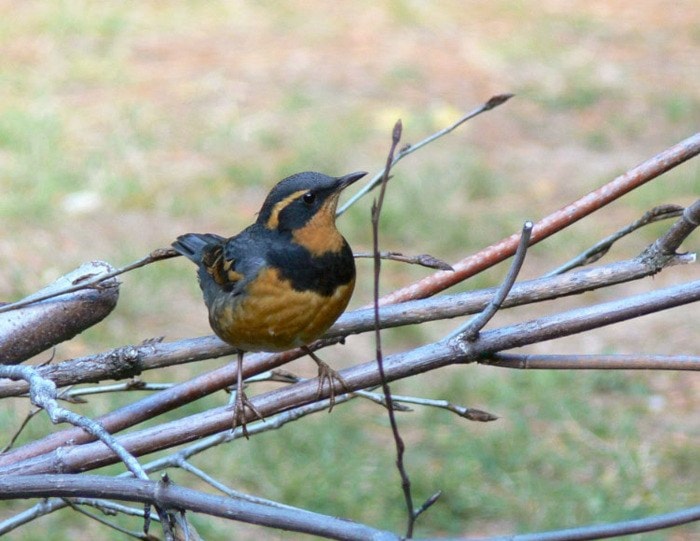Now wouldn’t you say that’s quite an original name for a bird?
Another and I were talking about this bird and they said, “Oh, we hear that bird, too. We call it the squeaky brake bird.” I’m not sure that’s the most becoming name for a bird, although it does kind of describe its call. The name doesn’t do much for the bird’s reputation, especially when the rest of this bird’s clan are all melodious singers. I guess, among birds, as far as the call goes, some may call it the black sheep of the thrush family. I’d better reveal the proper name of this squeaky brake bird in case some of you haven’t already figured it out. By the way, another descriptive name for it is “swamp robin”.
The varied thrush is one of a fivesome, including the American robin, Swainson’s thrush, hermit thrush and the veery. All of these perform best in early morning or at twilight. The varied thrush gives a long single-pitched call. Sometimes, it gives a very high-pitched long whistle a very low-pitched long trill or anything in between. You might hear a long e-e-e-e-e-e-e or a lower-pitched sports whistle-like trill.
The varied thrush has a red breast, something like a robin, excepting a black collar below the throat. Both, as adults, are much different in appearance from the other thrushes, which, as adults, have varying degrees of spotted or speckled breasts. However, to some degree, all of the young of the five thrush species share the spotted breast.
The varied thrush usually calls from the top of an evergreen tree and that should separate it from a real squeaky brake. Its call carries best on a cool spring morning or evening. Sometimes, I have heard them very clearly when whistling in fog or light rain. Recently, I stopped in an early morning rain to listen to four thrushes calling from around the cabin, and yet it is seldom I see more than one at a time feeding on the ground around the bird feeders. The males are much more solitary in their feeding habits than are redpolls and pine siskins.
A shyer bird than a robin is a varied thrush. A robin will share a lawn where someone is walking around. But a varied thrush, on the slightest movement, will make a beeline to the forest, where it will chirp loudly from some secluded perch. It seems that whenever I spot this bird in the forest or feeding on the ground around the feeder, it is ready for flight. Its forward-leaning stance bespeaks escape. It’s the same when I am near its nest. They are quicker than many birds to leave the next when I approach. In fact, they are quite likely to desert a nest with eggs if frightened off of it too often. They will start over and have successful broods hatched from those robin-like bright blue eggs, typical of the thrush species. Unlike the robin, the varied and other thrushes build their nests without using mud.
Members of the thrush family are found from valley bottom to nearly mountaintop. In this area, the hermit thrush, along with a few solitary robins, nest the highest on the mountains. They will nest on the ground or very close to ground level. In the valleys, veeries inhabit cottonwood groves, while Swainson’s thrush inhabit upland forests. You will find varied thrushes in damp and sometimes swampy cedar-hemlock forests, hence the name, swamp robin.
Ed McMackin is a biologist by profession but a naturalist and hiker by nature. He can be reached at 250-866-5747.
